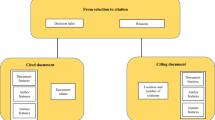Abstract
The citation frequency is taken into account when monitoring the research output of institutions; a citation index should be provided when filling in grant applications or participating in competitions for support and is critical for additional incentives. This paper presents the results of an analysis of publications in physico-chemical biology from one of the institutes in the Research Center. These publications have not been cited since 2014. The authors explore the effects of different potential factors on the numbers of citations, provide recommendations for increasing the publication visibility in the scientific network




Similar content being viewed by others
REFERENCES
Sharabchiev, Yu.T., The use of scientometric methods for monitoring the productivity of scientific activities, Mezhdunar. Obz.: Klin. Prakt. Zdorov’e, 2013, no. 4, pp. 118–133.
Smith, L.C., Citation analysis, Libr. Trends, 1981, vol. 30, no. 1, pp. 83–110.
Bornmann, L. and Daniel, H., What do citation counts measure? A review of studies on citing behavior, J. Doc., 2008, vol. 64, no. 1, pp. 45–80. https://doi.org/10.1108/00220410810844150
Soper, M.E., Characteristics and use of personal collections, Libr. Q., 1976, vol. 46, pp. 397–415.
Daud Ali, Amjad Tehmina, Siddiqui Muazzam Ahmed, et al., Correlational analysis of topic specificity and citations count of publication venue, Libr. Hi Tech, 2019, vol. 37, no. 1, pp. 8–18.
Kara-Murza, S.G., Citation in science and approaches to assessing the scientific contribution, Vestn. Akad. Nauk SSSR, 1984, no. 5, pp. 68–75.
Cole, S., The growth of scientific knowledge: Theories of deviance as a case study, in The Idea of Social Structure, Routledge, 2017, pp. 175–220.
Beaver, D.B., Does collaborative research have greater epistemic authority?, Scientometrics, 2004, vol. 60, pp. 399–408.
Soper, M.E., Characteristics and use of personal collections, Libr. Q., 1976, vol. 46, no. 4, pp. 397–415.
Baldi, S., Normative versus social constructivist processes in the allocation of citations: A network-analytic model, Am. Sociol. Rev., 1998, vol. 63, no. 6, pp. 829–846.
Stewart, J.A., Achievement and ascriptive processes in the recognition of scientific articles, Social Forces, 1983, vol. 62, no. 1, pp. 166–189.
Ayres, I. and Vars, F.E., Determinants of citations to articles in elite law reviews, J. Legal Stud., 2000, vol. 29, no. s1, pp. 427–450.
Laband, D.N. and Piette, M.J., Favoritism versus search for good papers: Empirical evidence regarding the behavior of journal editors, J. Polit. Econ., 1994, vol. 102, no. 1, pp. 194–203.
Smart, S. and Waldfogel, J., A citation-based test for discrimination at economics and finance journals, Natl. Bur. Econ. Res., 1996, no. w5460.
Mählck, P. and Persson, O., Socio-bibliometric mapping of intra-departmental networks, Scientometrics, 2000, vol. 49, no. 1, pp. 81–91.
White, H.D., Authors as citers over time, J. Am. Soc. Inf. Sci. Technol., 2001, vol. 52, no. 2, pp. 87–108.
Beskaravainaya, E.V. and Kharybina, T.N., Consolidation of scientists: Contribution of employees working abroad to research areas of scientific schools of the Institute for Protein Research of the Russian Academy of Sciences., Inf. Resur. Ross., 2014, no. 5, pp. 27–32.
Beskaravainaya, E.V. and Kharybina, T.N., Dynamics of bibliometric indicators of employees of scientific schools of the Institute for Protein Research of the Russian Academy of Sciences, in Sb. nauch. trudov (Scientific Proceedings), Kalenov, N.E. and Tsvetkova, V.A., Eds., Moscow: BEN RAN, 2015, pp. 63–73.
Beskaravainaya, E.V. and Kharybina, T.N., Creating a model for scientific research monitoring, Sci. Tech. Inf. Process., 2019, vol. 46, no. 2, pp. 100–109.
Simkin, M.V. and Roychowdhury, V.P., A mathematical theory of citing, J. Am. Soc. Inf. Sci. Technol., 2007, vol. 58, no. 11, pp. 1661–1673. https://arxiv.org/ftp/ physics/papers/0504/0504094.pdf.
Van Raan, A.F.J., Sleeping beauties in science, Scientometrics, 2004, vol. 59, no. 3, pp. 467–472.
Mokhnacheva, Yu.V., Citation of scientific publications: Features and patterns, Nauchn. Tekh. Bibl., 2017.
Garfield, E., Citation analysis as a tool in journal evaluation, Science, 1972, vol. 178, no. 4060, pp. 471–479.
Author information
Authors and Affiliations
Corresponding authors
Ethics declarations
The authors declare that they have no conflicts of interest.
About this article
Cite this article
Beskaravainaja, E.V., Kharybina, T.N. Analysis of the Factors That Affect the Citability of Research Articles. Sci. Tech. Inf. Proc. 47, 119–125 (2020). https://doi.org/10.3103/S0147688220020070
Received:
Published:
Issue Date:
DOI: https://doi.org/10.3103/S0147688220020070




